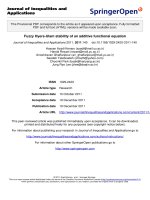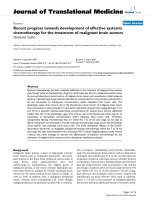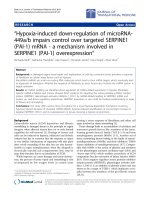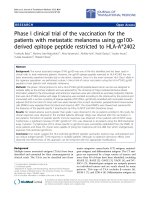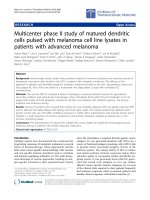báo cáo hóa học: " e differential mediating effects of pain and depression on the physical and mental dimension of quality of life in Hong Kong Chinese adults" pptx
Bạn đang xem bản rút gọn của tài liệu. Xem và tải ngay bản đầy đủ của tài liệu tại đây (215.68 KB, 6 trang )
SHOR T REPOR T Open Access
The differential mediating effects of pain and
depression on the physical and mental
dimension of quality of life in Hong Kong
Chinese adults
Wing S Wong
1*
, Simon TM Chan
2
, Vivian BK Fung
3
, Richard Fielding
3
Abstract
Objective: The impact of pain and depression on health-related quality of life (QoL) is widely investigated, yet the
pain-depression interactions on QoL remain unclear. This study aims to examine the pain-depression-QoL
mediation link.
Methods: Pain severity were assessed in a sample of Chinese professional teachers (n = 385). The subjects were
also assessed on depressive symptoms and QoL. Regression models were fitted to evaluate the pain-depression-
QoL relationships.
Results: About 44% of the sample had 3-5 painful areas in the past 3 months. Shoulder pain (60%) and headache
(53%) were common painful areas. The results of regression analyses showed that pain mediated the effects of
depression on the mental aspect of QoL (standardize d b = -0.111; Sobel test: z = -3.124, p < 0.005) whereas
depression mediated the effects of pain on the physical aspect of QoL (standardized b = -0.026; Sobel test: z =
-4.045, p < 0.001).
Conclusions: Our study offered tentative evidence that pain and depression impacted differently on the mental
and physical aspect of QoL. As these findings were based on a Chines e teacher sample, future studies should
employ more representative samples across cultures to verify the present data.
Introduction
Chronic pain and depression are often co-morbid. The
prevalence of depression among pain patients ranges
from 10% [1] to 100% [2], whereas about 30% [3] to
100% [4] of depressed patients report pain. The nature
and mechanism of the pain-depression association has
been widely investigated [5], yet remain largely incon-
clusive. Research on the causal direction(s) of the pain-
depression relationship has focused on three major lines
of investigation [6]. First, depression as a precursor for
pain, sensitizing a person to experience pain [7]. Second,
depression as a result of pain due to the sustained
reduction in physical and social activities [8]. Lastly,
depression and pain share the same or similar underly-
ing biophysiological mechanisms [9].
The impact of pain and depression on health-related
quality of life (QoL) has been well documented. Pain
impacts different aspects of QoL and impairs general
health perceptions among cancer patients [10]. Pain also
impairs mental and physical functioning and generates
severe anxiety [ 11]. Depressed individuals generally
report poorer QoL [12]. Depression predicted QoL
among bereaved adults [13] and in patients with cancer
[14]. Both pain and depression independently predicted
QoL in Chinese cancer patients [15]. Despite these links
between QoL, pain and depression, clarification of any
pain-depression interactions impacting QoL is lacking.
Specifically, the extent to wh ich pain exerts differential
effects on QoL with different domains was unclear. We
therefore explored the relationships between pain,
* Correspondence:
1
Department of Applied Social Studies, City University of Hong Kong,
Kowloon Tong, Hong Kong
Wong et al. Health and Quality of Life Outcomes 2010, 8:1
/>© 2010 Wong et al; licensee BioMed Central Ltd. This is an Open Access article distributed under the terms of the Creative Commons
Attribution License ( which permits unrestricted use, distribution, and rep roduction in
any medium, provided the original work is properly cited.
depression, and QoL, considering the mediating effects
of both pain and depression on two core dimensions of
QoL, physical and mental.
Methods
Following IRB approval, questionnaires were sent to 14
primary schools which were randomly selected from the
New Territories district in Hong Kong. A total of 385
(response rate: 72%) professional teachers completed the
questionnaires. About 78% were females and over half
fell into the age group of 21-30 (31.7%) or 31-40 (38.1%)
years. About 40% were Christians whereas 52% were
married.
Pain severity
Pain severity was first identified by affirmative answer to
a question, “Are you currently troubled by physical pain
for ≥ 3 months?” Subjects answering yes to the question
were then assessed using the Chronic Pain Grade (CPG)
questionnaire [16], a seven-item instrument assessing
severity in three dimensions: persistence, intensity and
disability. The three intensity items ask respondents to
rate their current, average and worst pain intensity on 0
- 10 Numerical Rating Scales (NRS) (0 = “ No pain at
all"; 10 = “ Pain as bad as could be” ). A Characteristic
Pain Intensity Score (score range: 0-100) is derived by
averaging the responses to the intensity items and mul-
tiplying this by 10. Three CPG items assess pain inter-
ference with (1) daily activ ities, (2) social activities, and
(3) working ability using 0 - 10 NRSs (0 = “No interf er-
ence/change"; 10 = “ Unable t o carry on activities/
extreme change”). The CPG Disability Score (score
range: 0-100) is derived by multiplying the average of
the three inte rference items by 10. Persisten ce is
assessed in the original CPG by a sking the respondent
to indicate the number of days out of the past six
months days that he or she was disabled by pain
(although we modified this to “the past three months”
because chronic pain is now defined as pain that per-
sists for at least three months
24
). The Disability Score
and the number of disability days are recoded into 5-
point scales (Disability Score: 0 = “0-29”,1=“30-49 ”,2
= “50-69”,3=“70 or above"; Disability Days: 0 = “0-6
days”,1=“ 7-14 days”,2=“ 15-30 days”,3=“ 31 days
or above” ) and summed, yielding “Disability Points” .
Based on the Pain Intensity Score and Disability Points,
CPG classifies chronic pain into five hierarchical grades:
Grade Zero (pain free), Grade I (low disability-low
intensity), Grade II (low disability-high intensity), Grade
III (high disability-moderately limiting) and Grade IV
(high disability-severely limiting). Previous reports indi-
cated that CPG is a valid and reliable instrument [17].
The Chinese version of CPG also demonstrated good
psychometric properties in a Chinese community sam-
ple [18].
Depression
The 7-item depression subscale of the Hospital A nxiety
and Depression Scale (HADS-D) [19] was employed to
evaluate depressive symptoms of the respondents. The
HADS-D is scored between 0 and 21, with higher scores
indicating greater levels of depressive symptoms. The
Chinese version has good psychometrics [20]. A cut-off
score of 8 was recommended for HADS-D for both the
Western and Chinese population [19,20].
Quality of life
Respondents also answered the Medical Outcomes
Study 12-item Short-Form Health Survey (SF12) [21].
The 12 questions are summarized into a physical com-
ponent (SF12-PCS) score and a mental component
score (SF12-MCS). The SF12 has been translated into
Chinese and validated in Hong Kong [22].
Statistical Analysis
Descriptive statistics assessed pain characteristics,
depression, and QoL scores of the sample. Regression
models were used to investigate the pain-depression-
QoL mediation chain. Separate models were fitted to
SF12-MCS and SF12-PCS in examining QoL as an out-
come variable. For pain to be a mediator o f depression
and QoL, four criteria as propose d by Baron and Kenny
[23] need to be met: (1) depression should significantly
predict pain, (2) pain should significantly predict QoL,
(3) depression should significantly predict QoL, and (4)
controlling for pain, the relationship between depression
and QoL should be reduced or no longer significant.
Perfect mediation is established if the association
between depression and QoL is reduced to zero. The
Sobel test [24] determined whether pain carried the
influence of depressi on to QoL. These criteria were also
applied to test the mediating effect of depression. A ser-
ies of four regression models were used to individually
test each of these three-variable mediation chains. The
results of separate regression analyses showed none of
the socio-demographic variables predicted QoL (all p >
0.05); they w ere therefore dropped as covariates from
subsequent regression models. In all regression analyses,
the pain variable was indexed by the CPG classification
as it takes into account both pain intensity and pain dis-
ability. All data analyses were performed using SPSS
version 15.0.
Results
Prevalence of pain, CPG classification, and means scores
of depression and QoL measures
Only 8% of the sample reported no pain symptom in the
past 3 months (Table 1). Those with pain symptoms
(92%) experienced an aver age of 3 .81 painful areas ( SD
= 2.53) with 44% reporting 3-5 painful areas. Of the
symptomatic subjects, 20% met the classification of
Grade III or above. The proportions of those being
Wong et al. Health and Quality of Life Outcomes 2010, 8:1
/>Page 2 of 6
classified as Grade Zero, Grade I, and Grade II were 0%,
31.1%, and 45.3% respectively. The mean scores o f
HADS-D, SF12-MCS, and SF12-PCS were 7.63 ( SD =
3.87), 35.72 (SD = 5.75), 35.80 (SD = 9.28) respectively.
Mediation in the pain-depression-QoL relationships
The results of Model 1 (Table 2) showed a significant
inverse relationship between depression scores and men-
tal QoL (b = -0.154, p < 0.05), whereas depression was
positively related to pain (b =0.271,p < 0.001). Pain
was significantly and i nversely r elated t o QoL (b =
-0.201, p < 0.001). When mediation was controlled,
depr ession remained inversely associated with QoL (b =
-0.111, p < 0.005), demonstrating a partial mediation
effect of pain between depression and QoL. Sobel’stest
indicated pain’s role a s a mediator the depression-QoL
relationship (z = -3.124, p < 0.005) (Figure 1).
In Model 2, depression was inversely associated with
physical QoL (b = -0.311, p < 0.001) and pain was inver-
sely associated with QoL (b = -0.106, p <0.05).After
controlling for pain, depression remained significantly
associated w ith QoL (b = -0.304, p < 0.001). The result
of Sobel test however suggested the reduction in stan-
dardized beta coefficients after controlling for mediation
was not significant (z = -1.929, p > 0.05)
Results of Model 3 indicated that after controlling for
depression, pain significantly associated with mental
QoL (b = -0.170, p <0.05).Althoughthestandardized
beta coefficients were reduced after controlling for med-
iation, the reductio n was not statistically significant as
suggested by the Sobel test (z = -1.853, p > 0.05).
In Model 4, after controlling for depression, pain no
longer significantly associated with physical QoL (b =
-0.026, p > 0.05). The result of Sobel test offered further
evidence for the pa rtial mediating effect of de pression to
the pain-QoL association (z =-4.045,p < 0.001) (Figure 2).
Discussion
We know of no other prior studies that evaluated the
pain-depression-QoL mediation chain by testing the dif-
ferential effects on the phy sical and mental dimension
of QoL independently. Regression analyses showed that
pain and depression impacted differently on the mental
and physical aspect of QoL. Pain significantly mediated
the depression-QoL link for the mental aspect (Model
1) whereas depression significantly mediated the pain-
QoL link for the physical aspect (Model 4). When pain
was the mediator, it acc entuated the n egative effects of
depr ession on mental functioning. The ind irect effect of
pain on the depression-QoL pathway was 0.043, suggest-
ing that about 28% of the effect of depression on the
mental aspect of QoL went through the mediator of
pain, and over 72% of the effect was direct. When
depression was the mediator, depressive symptoms
accentuated the negative effects of pain on physical
QoL. The indirect effect of depression on the pain-QoL
link pathway was 0.08, indicating that about 75% of the
effect of pain on QoL impacted through the mediator of
depression, and 25% of the effect was direct. Statistically,
the mediatio n of depression (Model 4: 75%) exerted the
strongest effect (cf. Model 1: 28%). These findings offer
insights to the current understanding on the pain-
depression relationship that whether pain and depres-
sion be a predictor or mediator in impacting QoL is
dependant on the specific aspect of QoL in question.
The high prevalence of pain symptoms (92%) might be
explained by the ubiquitous use of computers in the
Table 1 Pain characteristics and means of depression and
QoL measures
Pain measures n (%)
Number of pain areas
a
, M (SD) 3.81 (2.53)
0 30 (8)
1-2 95 (25)
3-5 164 (44)
6-9 75 (20)
10+ 10 (3)
Pain locations
b
Shoulder 224 (60)
Head 199 (53)
Neck 176 (47)
Leg 166 (44)
Back 149 (40)
Hand 95 (25)
Stomach 93 (25)
Joint 75 (20)
Menstrual 73 (20)
Abdomen 63 (17)
Tooth 51 (14)
Chest 48 (13)
Others 12 (3)
Chronic Pain Grade classification
b
Grade 0 0
Grade I 107 (31.1)
Grade II 156 (45.3)
Grade III 65 (18.9)
Grade IV 4 (1.2)
Pain Intensity, M (SD) 56.41 (16.95)
Depression
c
, M (SD) 7.63 (3.87)
Quality of life, M (SD)
SF12-MCS 35.72 (5.75)
SF12-PCS 35.80 (9.28)
Note: SF12: Medical Outcomes Study 12-item Short-Form Health Survey; MCS:
Mental Component Score; PHS: Physical Component Score; M: Mean; SD:
Standard deviation.
a
A total of 11 cases with missing data on the number of pain areas item.
b
Only respondents with at least one pain location (n = 344) were included in
the analyses. Twelve respondents with pain symptoms had missing data on
the CPG items.
c
Indexed by Hospital Anxiety and Depression Scale Depression subscale.
Higher scores indicate greater psychological distress.
Wong et al. Health and Quality of Life Outcomes 2010, 8:1
/>Page 3 of 6
teaching profession. Yet, further investigation is needed
to confirm the current prevalence estimate of chronic
pain among professional teachers. It should be noted
that among the symptomatic subjects, 28.5% of them
were classified as Grade Zero, suggesting that pain did
not lead to disability among these subjects. Research has
documented a higher tendency for somatization in Chi-
nese culture [25]. However, as we did not assess pain
etiology or somatization, we cannot determine from the
present data whether s omatization contributed to the
high prevalence of pain.
Despite the significant findings from this exploratory
study, the relationship between pain, depression, and
QoL should be considered ten tative. While the present
study assessed pain severity, future investigations should
explore how different dimensions of pain (e.g., pain
Without mediation: -0.154**
-0.201*** 0.271***
QoL (Mental)
With mediation: -0.111**
Depression
Pain
Figure 1 Standardized beta coefficient in pain partially mediated pathway from depression to QoL (mental).**p < 0.005; *** p < 0.001.
Table 2 Regression models testing the Pain-Depression-QoL mediation chain
a
Model Std b SE 95% CI P value
Model 1: Pain mediates the Depression-QoL (Mental)
b
link
Depression (Predictor) → QoL (Outcome) -0.154 0.078 -0.381, -0.074 0.004
Pain (Mediator) → QoL (Outcome) -0.201 0.119 -0.689, -0.222 <0.001
Depression (Predictor) → Pain (Mediator) 0.271 0.033 0.113, 0.243 <0.001
Depression (Predictor) → QoL (Outcome)|Pain (Mediator)
c
-0.111 0.081 -0.628, -0.143 0.002
Sobel test z = -3.124 P = 0.002
Model 2: Pain mediates the Depression-QoL (Physical)
d
link
Depression (Predictor) → QoL (Outcome) -0.311 0.121 -0.982, -0.504 <0.001
Pain (Mediator) → QoL (Outcome) -0.106 0.195 -0.769, -0.004 0.048
Depression (Predictor) → QoL (Outcome)|Pain (Mediator)
c
-0.304 0.127 -0.981, -0.480 <0.001
Sobel test z = -1.929 P = 0.054
Model 3: Depression mediates the Pain-QoL (Mental)
b
link
Pain (Predictor) → QoL (Outcome)|Depression (Mediator)
e
-0.170 0.123 -0.324, -0.006 0.042
Sobel test z = -1.853 P = 0.064
Model 4: Depression mediates the Pain-QoL (Physical)
d
link
Pain (Predictor) → QoL (Outcome)|Depression (Mediator)
e
-0.026 0.195 -0.479, 0.286 0.620
Sobel test z = -4.045 P < 0.001
Note: QoL: Quality of life; Std b: Standardized beta coefficient; SE: Standard error; CI: Confidence interval.
a
Four separate regression models were generated to test the pain-depression-QoL mediation chain.
b
QoL was indexed by SF12-MCS.
c
Pain, as mediator, was controlled in the regression equation.
d
QoL was indexed by SF12-PCS.
e
Depression, as mediator, was controlled in the regression equation.
Wong et al. Health and Quality of Life Outcomes 2010, 8:1
/>Page 4 of 6
location and number of pain areas) impact depression
and QoL. As other factors may also be involved in the
mediation chain, future attempts should also explore the
possible range of interaction between variables. Also, the
extent to which causes of pain symptoms influence the
relationship between pain and physical QoL remain
unclear; this issue should be addressed in future
research. The cross-sectional design of this study did
not allow us to infer causality. Cautions should be exer-
cised when interpreting and generalizing the current
findings in other populations as the present sample con-
sisted of mainly Chinese female (78.2%) teachers. Pre-
vious studies show that the experience of pain varies
across cultures. Replication of the present findings in
other cultures is t herefore warranted [26,27]. Even
within the Chinese population, future studies should
validate the present finding using a more representative
sample with diverse socio-economic background.
Author details
1
Department of Applied Social Studies, City University of Hong Kong,
Kowloon Tong, Hong Kong.
2
Department of Social Work, Hong Kong Baptist
University, Hong Kong.
3
Department of Community Medicine, The University
of Hong Kong, Pokfulam, Hong Kong.
Authors’ contributions
WSW, STMC and RF designed the questionnaire. WSW and VBKF performed
statistical analysis. WSW drafted the manuscript; RF participated in editing
the manuscript.
All authors read and approved the final manuscript.
Competing interests
The authors declare that they have no competing interests.
Received: 20 June 2009
Accepted: 7 January 2010 Published: 7 January 2010
References
1. Piloswky I, Chapman CR, Bonica JJ: Pain, depression, and illness behavior
in a pain clinic population. Pain 1977, 4:183-192.
2. Turkington RW: Depression masquerading as a diabetic neuropathy.
JAMA 1980, 243:1147-1150.
3. Gallemore JL, Wilson WP: The complaint of pain in the clinical setting of
affective disorders. Southern Medical Journal 1969, 62:551-555.
4. Ward NG, Bloom VL, Friedel RO: The effectiveness of tricyclic
antidepressants it the treatment of coexisting pain and depression. Pain
1979, 7:331-341.
5. Brown GK: A causal analysis of chronic pain and depression. Journal of
Abnormal Psychology 1990, 99:127-137.
6. Robinson ME, Riley JL: The role of emotion in pain. Psychosocial factors in
pain: Clinical perspective New York: GuilfordGatchel RJ, Turk DC 1999, 74-88.
7. Blumer D, Heilbronn M: Chronic pain as a variant of depressive disease:
The pain-prone disorder. Journal of Nervous and Mental Disease 1982,
170:381-406.
8. Hendler N: Depression caused by chronic pain. Journal of Clinical
Psychiatry 1984, 45:30-36.
9. Magni G: On the relationship between chronic pain and depression
when there is no organic lesion. Pain 1987, 31:1-21.
10. Anie KA, Steptoe A, Bevan DH: Sickle cell disease: Pain, coping and
quality of life in a study of adults in the UK. British Journal of Health
Psychology 2002, 7:331-334.
11. Wang XS, Cleeland CS, Mendoza TR, Engstrom MC, Liu S, Xu G, Hao X,
Wang Y, Ren XS: The effects of pain severity on health-related quality of
life: a study of Chinese cancer patients. Cancer 1999, 86(9):1848-1855.
12. Moses T, Leuchter AF, Cook I, Abrams M: Does the clinical course of
depression determine improvement in symptoms and quality of life?.
The Journal of nervous and mental disease 2006, 194(4):241-248.
13. Boelen PA, Prigerson HG: The influence of symptoms of prolonged grief
disorder, depression, and anxiety on quality of life among bereaved
adults: A prospective study. European archives of psychiatry and clinical
neuroscience 2007, 257(8):444-452.
14. Skarstein J, Aass N, Fossa SD, Skovlund E, Dahl AA: Anxiety and depression
in cancer patients: relation between the Hospital Anxiety and
Depression Scale and the European Organization for Research and
Treatment of Cancer Core Quality of Life Questionnaire. Journal of
psychosomatic research 2000, 49(1):27-34.
15. Wong WS, Fielding R: Eating ability predicts subsequent quality of life in
Chinese patients with breast, liver, lung, or nasopharyngeal carcinoma:
A longitudinal analysis. Acta Oncologica 2008, 47(1):71-80.
16. Von Korff M, Dworkin SF, Le Resche L: Graded chronic pain status: an
epidemiologic evaluation. Pain 1990, 40(3):279-291.
17. Elliott AM, Smith BH, Smith WC, Chambers WA: Changes in chronic pain
severity over time: the Chronic Pain Grade as a valid measure. Pain 2000,
88(3):303-308.
18. Fielding R, Wong WS: The prevalence of chronic pain, fatigue, and
insomnia in the general population of Hong Kong. Final report to the
Health, Welfare and Food Bureau, Government of the Hong Kong
Without mediation: -0.106*
-0.311***
0.271***
QoL (Physical)
With mediation-0.026
Pain
Depression
Figure 2 Standardized beta coefficient in depression partially mediated pathway from pain to QoL (physical).*p < 0.05; *** p < 0.001.
Wong et al. Health and Quality of Life Outcomes 2010, 8:1
/>Page 5 of 6
Special Administrative Region, China. Hong Kong: School of Public Health,
the University of Hong Kong 2008.
19. Zigmond AS, Snaith RP: The hospital anxiety and depression scale. Acta
Psychiatr Scand 1983, 67(6):361-370.
20. Leung CM, Ho S, Kan CS, Hung CH, Chen CN: Evaluation of the Chinese
version of the Hospital Anxiety and Depression Scale. A cross-cultural
perspective. Int J Psychosom 1993, 40(1-4):29-34.
21. Ware JE: SD-36 Health Survey Manual and Interpretation Guide. Boston:
Nomrod Press 1993.
22. Lam CL, Tse EY, Gandek B: Is the standard SF-12 health survey valid and
equivalent for a Chinese population?. Qual Life Res 2005, 14(2):539-547.
23. Baron RM, Kenny DA: The moderator-mediator variable distinction in
social psychological research: Conceptual, strategic, and statistical
considerations. Journal of Personality and Social Psychology 1986, 6:1173-
1182.
24. MacKinnon DP, Lockwood CM, Hoffman JM, West SG, Sheets V: A
comparison of methods to test mediation and other intervening
variable effects. Psychological Methods 2002, 7:83-104.
25. Mak WW, Zane NW: The phenomenon of somatization among
community Chinese Americans. Soc Psychiatry Psychiatr Epidemiol 2004,
39(12):967-974.
26. Sheffield D, Biles PL, Orom H, Maixner W, Sheps DS: Race and sex
differences in cutaneous pain perception. Psychosomatic Medicine 2000,
62:517-523.
27. Edwards RR, Doleys DM, Fillingim RB, Lowery D: Ethnic differences in pain
tolerance: Clinical implications in a chronic pain population.
Psychosomatic Medicine 2001, 63:316-323.
doi:10.1186/1477-7525-8-1
Cite this article as: Wong et al.: The differential mediating effects of
pain and depression on the physical and mental dimension of quality
of life in Hong Kong Chinese adults. Health and Quality of Life Outcomes
2010 8:1.
Publish with BioMed Central and every
scientist can read your work free of charge
"BioMed Central will be the most significant development for
disseminating the results of biomedical research in our lifetime."
Sir Paul Nurse, Cancer Research UK
Your research papers will be:
available free of charge to the entire biomedical community
peer reviewed and published immediately upon acceptance
cited in PubMed and archived on PubMed Central
yours — you keep the copyright
Submit your manuscript here:
/>BioMedcentral
Wong et al. Health and Quality of Life Outcomes 2010, 8:1
/>Page 6 of 6
